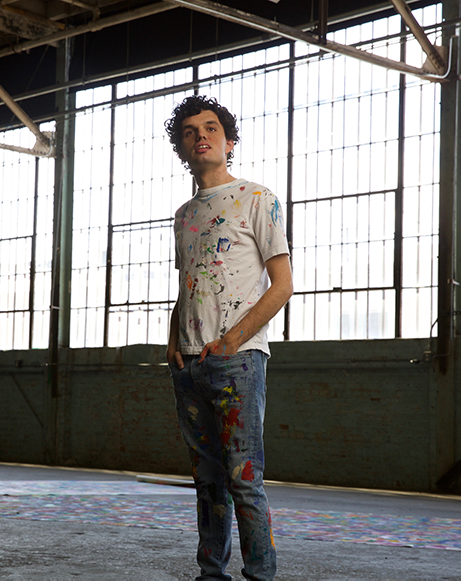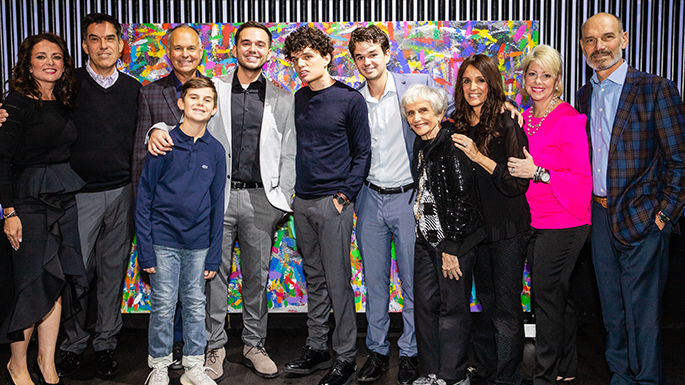|
Welcome to Spectrum Spotlights! Each month, we'll introduce you to people with autism and within the autism community. We hope you enjoy their stories.

Photo by Tali Song Roth© |
Get to know Nicholas K.
A brain tumor at 15-months old. An autism diagnosis at 2-and-a-half. Brain surgery at 9 to mitigate debilitating seizures sometimes as many as 10 a day. To say that Nicholas has faced adversity throughout his life would be an understatement. Now 23, the Southern California native is thriving - expressing his unique passion for life through his vibrant paintings, a riot of primary colors.
Nicholas has suffered approximately 50,000 seizures throughout his life. As a result of this condition, as well as his autism and developmental delays, Nicholas has never been able to do many of the things his brothers, Michael, 26, and Christian, 19, can do, like play sports or even communicate using full sentences. But one thing Nicholas can do is express himself through his colorful, inspirational artwork that has touched countless people around the world.
This painting phenom has landed solo exhibitions in California, Idaho, Chicago, Georgia, New York and London, and sold paintings to celebrities and influencers like tennis superstar Roger Federer, Dean Spanos, who owns the National Football League’s Los Angeles Chargers, and the CEO’s of YouTube Red and Google. He’s even commissioned paintings for Kaiser Permanente and Adidas at Coachella.
Learn more about Nicholas, through the words of his mom, Krisann, in this edition of Spectrum Spotlights.
Did you realize something was different about Nicholas before his diagnosis? If so, please share some of your experiences and how the diagnosis came about.
Actually, no, we didn’t notice anything different about Nicholas before his diagnosis of epilepsy. In addition to some of the motor challenges, he is atypical in terms of his presentation for autism because of the structural impairment from the tumor. Once we learned of Nicholas’ related form of autism, we utilized resources immediately. First with Dori Brown at Boston Children’s Hospital and then with Dr. Doreen Granpeesheh and The Center of Autism and Related Disorders based in Woodland Hills, California. The center and its therapeutic approach greatly benefited Nicholas, under their supervision he continues to receive daily therapy as he has for 20 years.
In your experience, how important is early intervention?
Early intervention is imperative for the treatment and management of autism. Nicholas was able to learn through applied behavior analysis (ABA) treatment and discrete-trial training (DTT). Through these therapies, Nicholas learned how to eat at restaurants, sit and enjoy lengthy church services, swallow pills, avoid darting, follow simple instructions, work on fine and gross motor skills daily, and eventually leading to participating in ROTC, community activities, and mainstream art classes. What he learned to do through these therapies eventually gave him the foundation with which he was then able to express himself through his painting. I can’t emphasize enough to parents of young children with autism the importance of therapy and early intervention. We witnessed first-hand the fruit of hard work and good therapy. There is a treatment out there. Use all your resources to get that therapy for your child. Work with your insurer and school district and push for help.
Tell us about some of the things Nicholas struggles with as a result of his medical conditions.
Nicholas suffers from intractable seizures, right-sided weakness, dietary constraints, speech delay and coordination issues. He sometimes has to overcome 10 seizures in a day. Some days he has a lot of energy and he’ll paint standing up with a lot of fluidity, and sometimes he has to stay on the ground and paint large canvases sitting down. His paintings often reflect the physical state he is in on that particular day. Incredibly, the thing that means the most to all of us, is that people respond to his paintings because of their imperfections.
Please tell us about some of the things at which he excels, like his extraordinary abilities as an artist.
He loves color and texture. He has always been attracted to bright colors and if he sat behind someone in a brightly colored shirt, he would reach out and touch the shirt. After suffering a seizure, he works to start moving again immediately and will return to his canvases. Behaviors, seizures, motor problems, all contribute to his success as a painter. Painting is a very forgiving profession.
Nicholas also has an extraordinary ability to hold his breath underwater for long periods of time! He used to love doing this as a young child. He is also a master at catching tossed shrimp in his mouth when dining at Benihanas. 😊
How does Nicholas' personality show in his paintings?
Nicholas' approach is a classic case of the Tortoise and the Hare. In the absence of his ability to work quickly, Nicholas works consistently and deliberately. His colorful, crafted strokes have an organized chaos to them, which is a reflection of who he is and his challenges.

Photo by Tali Song Roth©
What are five words that best describe Nicholas?
Deep, Joyful, Humble, Loyal and Quirky.
Can you share what it’s like to be a mother of a child on the autism spectrum?
At first, being a mother of an autistic child felt overwhelming and frightening. But afterwards, you begin to understand the process better and seek out resources to assist in maximizing therapy. Once you see progress and the uniqueness of your child, you begin to celebrate even minor achievements and find the hidden joys that emerge daily.
If you could give one piece of advice to other parents who have a child with autism or other disabilities, what would you say?
I can’t emphasize enough the importance of early, intense immersion into ABA therapy. It allowed Nicholas to cultivate a solid foundation that would eventually provide him with the ability to find a path to a lovely job. Never give up. Intense therapy can make a difference. Don’t think that all the work you do when they’re little won’t lead to something…it can.
Also, it is important to stay positive and be flexible. When we were trying to find a job for Nicholas, he kept getting rejected for being too much of a liability. Restaurants and stores wouldn’t hire him because he could fall and injure himself when having a seizure and was a liability to most employers. Painting turned out to become a beautiful and forgiving career for him and it wouldn’t have happened if we allowed the many failures to dictate the outcome. We are always walking a fragile line, in terms of his health, but are grateful to God for the small victories every day.
How has Nicholas’ siblings played a role in providing him with guidance and support through the years?
Nicholas’ two brothers are like bookends, holding Nicholas up on either side. They treat him like any older/younger brother would teasing, encouraging and enjoying life with him. They know his limitations and then stretch them.
What makes you most proud of Nicholas?
That no matter how much he has gone through and suffered, he is not angry or upset or bitter. One stroke at a time, he enjoys the life he has been given.
You can see his paintings and check out his upcoming events on his website, nicholaskontaxis.com and find more information about Nicholas' most current show in Atlanta here! 
|
![]()
![]()